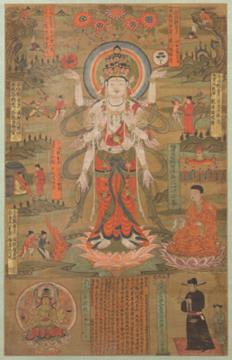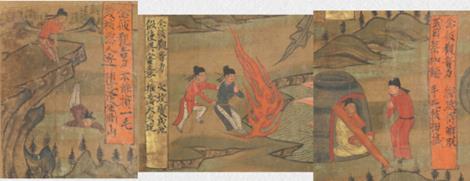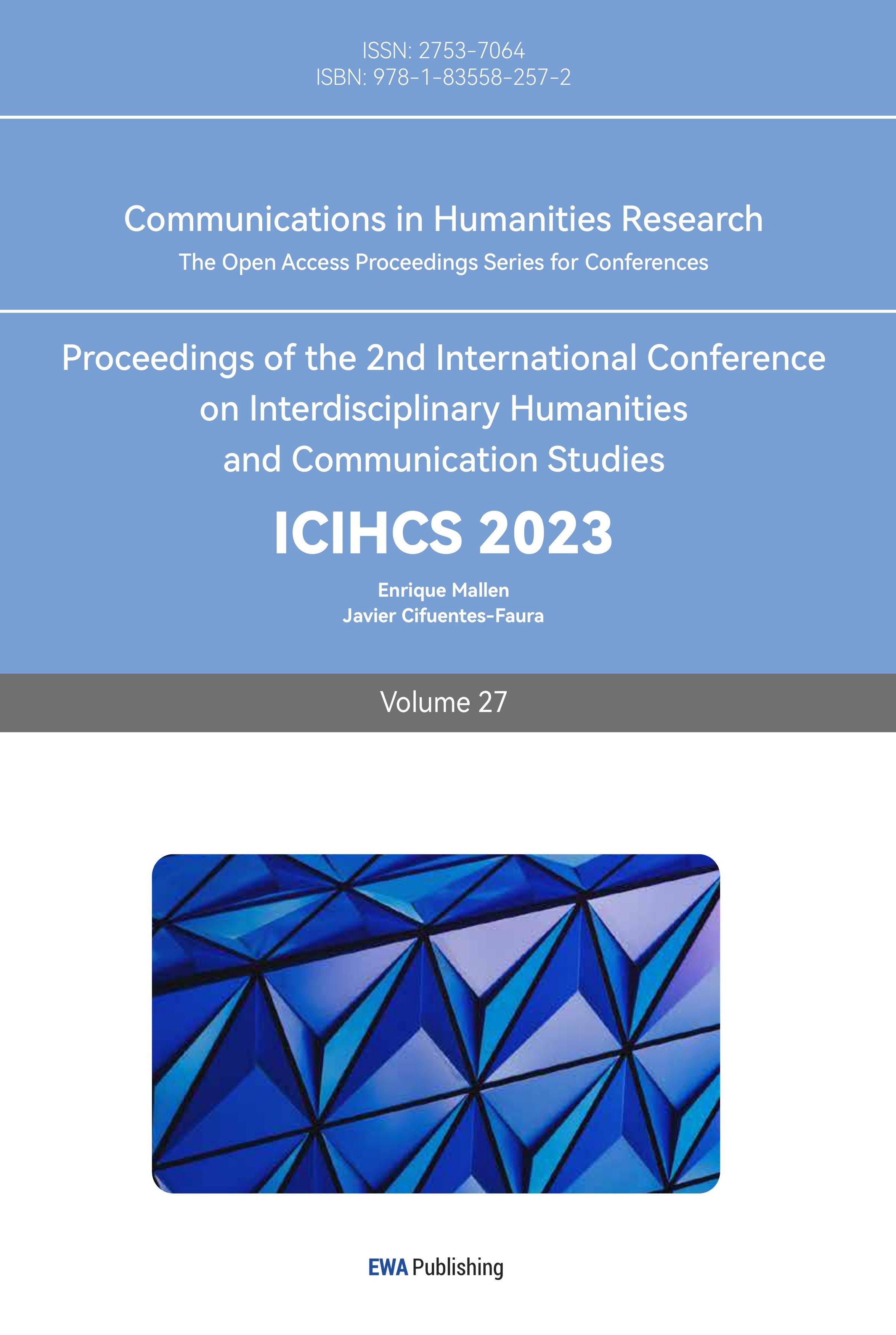1.Introduction
The painting of the eleven-headed Guanyin is from the Northern Song dynasty. It is a hanging scroll and is now in the Harvard Arts Museum (Figure 1). There are a great many inscriptions, either introducing characters or promoting morals of the arts. This is a distinctive feature of Chinese painting. The reformation of poetry and prose in the Northern Song Dynasty exerted influence over painting, thereby promoting and enhancing morals and further developing a school of painting done by amateur literati in that period [1]. The inscriptions are from the Lotus Sutra's Universal Gate Chapter on Avalokitesvara Bodhisattva. The main idea of the scroll is compassion. Guanyin is a bodhisattva of great compassion [2]. The inscriptions echo this idea.

Figure 1: Hanging scroll of the Eleven-headed Guanyin
The sculpture of the eleven-headed Guanyin is also from the Northern Song period (Figure 2). The eleven heads symbolize the Buddha’s path to enlightenment [3]. Since the Song dynasty, the interpretation of Guanyin has become female. The reason is that other than compassion and being able to relieve suffering, Guanyin also has the power to grant children [4]. This characteristic is unique and can be observed from the statue.

Figure 2: Statue of Eleven-headed Guanyin
Although there were suppressions of Buddhism in the Tang and Song Dynasties, Buddhism flourished in these periods. Buddhist monks played a significant role in the flourishment. Emperors ruled and managed the country by merging Buddhist monks’ religious thinking and policies [5]. Their thinking, for instance, etiquette education and central policy, affected the policies, religion, and social organization.
In this paper, the painting and sculpture of the Eleven-headed Guanyin from the aspects of appearance, decoration, gesture, and atmosphere are compared. For instance, interpretation and meanings behind, the representation of Guanyin. Using the method of comparison to find out differences and similarities of similar objects helps solve the question of their special characteristics in particular periods and sequences.
The question of Guanyin’s gender can be confusing. This paper analyzes some information about it. This research can help enhance cultural understanding and cultural awareness about East Asian Buddhism and Chinese traditional painting characteristics.
2.Hanging Scroll of Eleven-headed Guanyin in the Northern Song
A unique eleven-headed Guanyin scroll was created in the Northern Song, with ink and color on silk, retrieved from Dunhuang. Its dimension is 99.6cm * 2.8cm. It is a complicated painting with many details. This scroll is now in the Harvard Arts Museum [6].
2.1.Analysis of the Inscriptions
Adding inscriptions to paintings is a tradition in China and most of the artworks have this feature. Figure 3 shows one of the inscriptions on the scroll. The inscriptions are from the Lotus Sutra's Universal Gate Chapter on Avalokitesvara Bodhisattva, which is a very significant and influential sutra in Buddhism. The translation of inscriptions on the scroll is listed and explained below. “Good Man, if all the countless hundreds of thousands of millions of living beings tormented by misery and pain hear of Gwan Shr Yin Bodhisattva, and with all their hearts invoke his name, Gwan Shr Yin Bodhisattva will immediately respond to their prayers and set them free [7].” That means if one follows Guanyin’s spirit, one can be released from pain and can be set free. “If those who hold the name of Gwan Shr Yin Bodhisattva should fall into a great fire, the fire will not burn them, because of Gwan Shr Yin Bodhisattva’s awesome spiritual power. If they are being tossed about in deep and treacherous waters and call his name, they will quickly reach the shallows [7] .” That means one can be saved from danger and not be harmed by anything if one believes in Guanyin and calls his name. “If someone facing deadly harm recites Gwan Shr Yin Bodhisattva’s name, the weapons of the assailants will break apart and he will get away [7] ”, the meaning is that one can be saved from deadly harm, the weapons of the enemy will break apart, if one believes in Guanyin. “If there is a person, whether innocent or guilty, who is locked in stocks or shackled by ropes and chains, his fetters will snap and fall away, letting him go free as soon as he invokes Gwan Shr Yin Bodhisattva’s name [7].” One can enjoy freedom for eternity if he/she follows Guanyin’s spirit, no matter who is.
These are found in the twenty-fifth chapter of the Lotus Sūtra. This chapter is devoted to Avalokitesvara, describing him as a compassionate bodhisattva who hears the cries of sentient beings, and who works tirelessly to help those who call upon his name [8].
A portion of the long inscription is found beside a monk, it translates: “The late teacher, Yuanman, whose earthly name was Zhang, dedicated this with his whole heart.” In the Song and Yuan dynasties (960-1368), the monks appeared throughout Chan texts, and they became a popular and recurring theme in art. The inscription added here is to emphasize Yuanman’s faithfulness to Guanyin as a worshiper. In a nutshell, the inscriptions are used to emphasize Guanyin’s spirit–compassion or maybe serve as teaching materials of Buddhism.

Figure 3: Extract of inscriptions on the hanging scroll
2.2.The Mudras of Eleven-headed Guanyin in Hanging Scroll
In Figure 4, circled in red are two types of mudras. Mudras are symbolic or ritual gestures or poses in Buddhism [9]. Mudras in this painting are performed by hand. There are two types of mudra in the painting, which are Vitarka mudra and Varada mudra. The former is in front of Guanyin's chest while the latter is beside his legs. They represent the action of teaching and compassion respectively [10]. Therefore, other than for decoration use or worship, this hanging scroll is more likely to be used for educational purposes and promotion of compassion.

Figure 4: Mudras of Guanyin
2.3.The Decorations in the Scroll
According to Figure 1, colorful decorations can be found around the Guanyin. First, a colorful and big flower canopy is found above the Guanyin. Then, a lotus flower is found for Guanyin to stand on. The Lotus flower is a very significant feature in Buddhism. It is a representation of purity of speech and mind. In Chinese culture, a famous scholar Zhou DunYi appreciated lotus flowers “I love the lotus because while growing from mud, it is unstained”. Apart from these, there are gorgeous bracelets and necklaces worn by the Guanyin. For sculptures of Buddha, it is seldom to see that Buddha is wearing exquisite decoration. Paintings are different, it is a lot easier for artists to make the costumes colorful in a painting.
2.4.The Appearance of the Guanyin
From observation, the facial expression of the Guanyin looks nice, warm, and kind. This implies compassion. Apart from the mudras, he is holding plants and animals in both hands. They mean all living things and nature. This echoes another theory in Buddhism, which is from The Sūtra In Which The Buddha Speaks Of Immeasurable Life, a Buddha can deliver all living things from difficulty and save, and release them from suffering. The Guanyin’s appearance represents the ideas behind it, which are compassion and redemption.
3.Sculpture of Eleven-headed Guanyin in the Northern Song
The sculpture was created in the late Northern Song. It is made of wood with polychromy and cut gold. No obvious colors. Its height is around 218.5 cm. It has an obvious difference with the hanging scroll in the same period.
Firstly, the hanging scroll of Eleven-headed Guanyin and the sculpture have some similarities. By looking at the Guanyins’ facial expressions, both of them look very nice and warm looking. Even if the world is filled with suffering, wars, greed, cruelty, or anything, they have a compassionate heart.
Then, in the sense of the painting, the Guanyin is huge and wearing colorful clothes, surrounded by many other characters and exquisite decorations. All the other characters and decorations set off the importance of the Guanyin. There are inscriptions to explain and represent the main spirit of Guanyin. While, in the sense of the sculpture, it is simple but elegant. There are no special colors, and he is wearing cheap fabrics. This sculpture gives the impression that she has experienced the difficulties and suffering in the human world. Her hands are lost. However, it doesn’t seem to be broken or incomplete. In fact, she is a bodhisattva even if there are no mudras and a pretty dress. This echoes the idea in the Diamond Sutra, “If one sees all sorts of phenomena are not really the phenomena themselves, then one can see Tathâgata [11]”.
To sum up, the main point is that with a compassionate heart like the spirit of Guanyin, problems can be solved, and people can transcend challenges and be released from suffering. These might be the thoughts that the artists in that period wanted to deliver.
4.Discussion on Gender issues of Guanyin
Another interesting question that can be investigated more is the gender of Guanyin. By just observing Guanyin’s appearance in both the paintings and the sculpture, Guanyin looks more like a female. Representations of the bodhisattva in China before the Song dynasty (960–1279) were masculine in appearance. Images that later displayed attributes of both genders are believed to be in accordance with the Lotus Sutra, where Avalokitesvara has the supernatural power of assuming any form required to relieve suffering, and also has the power to grant children. Because this bodhisattva is considered the personification of compassion and kindness, a mother goddess and patron of mothers and seamen, it was further interpreted as an all-female in China around the 12th century. On occasion, Guanyin is also depicted holding an infant in order to further stress the relationship between the bodhisattva, maternity, and birth [12]. Thus, this can further prove that the appearance of Guanyin is considered and designed in order to show compassion.
5.Conclusion
To conclude, this research found that the eleven-headed Guanyin emphasized compassion and mercy significantly. Both art expression methods can show this representation successfully. For the painting, the ideas are shown in the inscriptions, mudras, facial expressions and minor characters. For the sculpture, the idea is shown in the facial expressions, appearance, and atmosphere. After the comparison, both art expression methods have their own upsides. They can both prove the theory of Gunyin’s spirit mentioned in Buddhism sutras. Paintings can express thoughts more directly due to diverse elements and inscriptions. Together with the gender symbolism of Guanyin starting from Song and Yuan, it is more firm that Guanyin is a bodhisattva of infinite compassion. However, due to the vast amount of details in the scroll, some elements cannot be analyzed completely in the future research, Buddhist art in China can be compared with Buddhist art in other countries, for instance, Thailand.
References
[1]. Qiao-bin, D. (2005). A Transformation in Literati Painting as Reflected from the Northern Song to the Southern Song Dynasties.)
[2]. The Jizo Bodhisattva Wish Sutra. See and Hear the Benefit No. 12
[3]. Anonymous. (2023). Eleven-headed guanyin. Retrieved from https://www.clevelandart.org/art/1981.53
[4]. Britannica, T. Editors of Encyclopaedia (2023, July 28). Avalokiteshvara. Encyclopedia Britannica.
[5]. Gu Zhengmei, "From the Heavenly King Tradition to the Buddha King Tradition: The Ideology of Buddhist Governance in Medieval China Research" (Taipei: Shangzhou Publishing House, 2003).
[6]. Harvard. (2023, August 24). Eleven-headed guanyin. https://harvardartmuseums.org/collections/object/204072
[7]. The Lotus Sutra. Translated by Kumārajīva; Tsugunari Kubo; Akira Yuyama (Rev. 2nd ed.). Berkeley, Calif.: Numata Center for Buddhist Translation and Research. 2007.
[8]. Baroni, Helen (2002). The Illustrated Encyclopedia of Zen Buddhism: p. 15
[9]. Encyclopædia Britannica. (2010). "mudra (symbolic gestures)". Retrieved October 11, 2010.
[10]. J. J. (2022). Buddha Purnima 2022: Know Buddhist mudras, hand gestures and their meaning. Retrieved from https://www.jagranjosh.com/general-knowledge/buddhist-mudras-hand-gestures-and-their-meaning-1486548951-1
[11]. Schopen, Gregory (2004). "Diamond Sutra". MacMillan Encyclopedia of Buddhism. Vol. 1. New York: MacMillan Reference USA. pp. 227–28.
[12]. Britannica, T. Editors of Encyclopaedia (2023, July 28). Avalokiteshvara. Encyclopedia Britannica.
Cite this article
Zhang,Y. (2024). Comparison Between Painting and Sculpture of Eleven-headed Guanyin in the Northern Song Dynasty. Communications in Humanities Research,27,82-87.
Data availability
The datasets used and/or analyzed during the current study will be available from the authors upon reasonable request.
Disclaimer/Publisher's Note
The statements, opinions and data contained in all publications are solely those of the individual author(s) and contributor(s) and not of EWA Publishing and/or the editor(s). EWA Publishing and/or the editor(s) disclaim responsibility for any injury to people or property resulting from any ideas, methods, instructions or products referred to in the content.
About volume
Volume title: Proceedings of the 2nd International Conference on Interdisciplinary Humanities and Communication Studies
© 2024 by the author(s). Licensee EWA Publishing, Oxford, UK. This article is an open access article distributed under the terms and
conditions of the Creative Commons Attribution (CC BY) license. Authors who
publish this series agree to the following terms:
1. Authors retain copyright and grant the series right of first publication with the work simultaneously licensed under a Creative Commons
Attribution License that allows others to share the work with an acknowledgment of the work's authorship and initial publication in this
series.
2. Authors are able to enter into separate, additional contractual arrangements for the non-exclusive distribution of the series's published
version of the work (e.g., post it to an institutional repository or publish it in a book), with an acknowledgment of its initial
publication in this series.
3. Authors are permitted and encouraged to post their work online (e.g., in institutional repositories or on their website) prior to and
during the submission process, as it can lead to productive exchanges, as well as earlier and greater citation of published work (See
Open access policy for details).
References
[1]. Qiao-bin, D. (2005). A Transformation in Literati Painting as Reflected from the Northern Song to the Southern Song Dynasties.)
[2]. The Jizo Bodhisattva Wish Sutra. See and Hear the Benefit No. 12
[3]. Anonymous. (2023). Eleven-headed guanyin. Retrieved from https://www.clevelandart.org/art/1981.53
[4]. Britannica, T. Editors of Encyclopaedia (2023, July 28). Avalokiteshvara. Encyclopedia Britannica.
[5]. Gu Zhengmei, "From the Heavenly King Tradition to the Buddha King Tradition: The Ideology of Buddhist Governance in Medieval China Research" (Taipei: Shangzhou Publishing House, 2003).
[6]. Harvard. (2023, August 24). Eleven-headed guanyin. https://harvardartmuseums.org/collections/object/204072
[7]. The Lotus Sutra. Translated by Kumārajīva; Tsugunari Kubo; Akira Yuyama (Rev. 2nd ed.). Berkeley, Calif.: Numata Center for Buddhist Translation and Research. 2007.
[8]. Baroni, Helen (2002). The Illustrated Encyclopedia of Zen Buddhism: p. 15
[9]. Encyclopædia Britannica. (2010). "mudra (symbolic gestures)". Retrieved October 11, 2010.
[10]. J. J. (2022). Buddha Purnima 2022: Know Buddhist mudras, hand gestures and their meaning. Retrieved from https://www.jagranjosh.com/general-knowledge/buddhist-mudras-hand-gestures-and-their-meaning-1486548951-1
[11]. Schopen, Gregory (2004). "Diamond Sutra". MacMillan Encyclopedia of Buddhism. Vol. 1. New York: MacMillan Reference USA. pp. 227–28.
[12]. Britannica, T. Editors of Encyclopaedia (2023, July 28). Avalokiteshvara. Encyclopedia Britannica.









